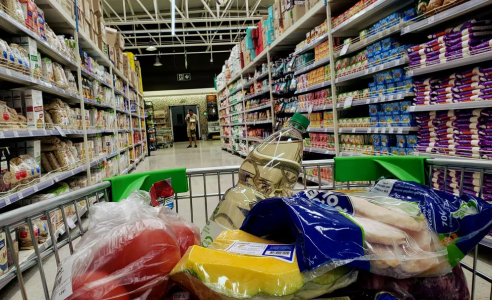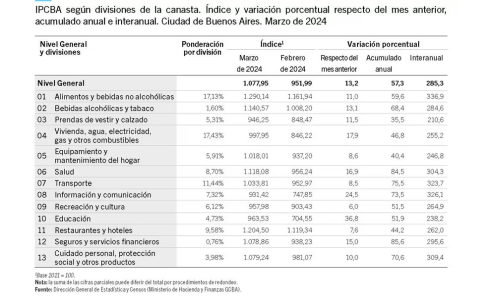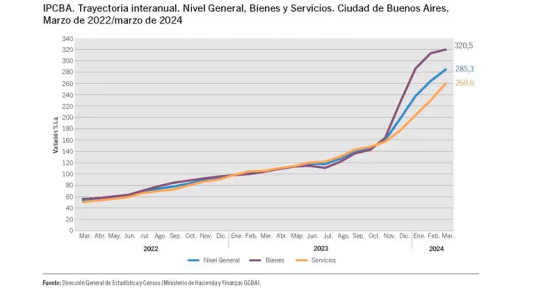All the Answers
Well-known member
Buenos Aires inflation was 13.2% in March and rose to 285.3% last year - Infobae

Source:

La inflación porteña fue del 13,2% en marzo y ascendió a 285,3% el último año
El aumento de precios mensual en la Ciudad de Buenos Aires marcó una desaceleración respecto de febrero. Educación e Información y Comunicación fueron los rubros de mayor aumento. Qué se espera a nivel nacional
April 09, 2024
The monthly price increase in the City of Buenos Aires marked a slowdown compared to February. Education and Information and Communication were the areas with the greatest increase. What is expected at the national level


IPCBA according to basket divisions
The category of Food and non-alcoholic beverages rose 11%, with an incidence of 2.31 percentage points at the General Level. Within the division, the main drivers were the increase in milk, dairy products and eggs (18.2%), meats and derivatives (9.4%), vegetables, tubers and legumes (22.4%) and bread and cereals (8.8%). For its part, Health advanced 16.9% due to increases in prepaid medicine fees.
In turn, Information and communication increased 24.5% due to increases in the rates of grouped communication services and mobile telephony. In the middle of the beginning of the school year, Education averaged an increase of 36.8% after adjustments in the fees of formal education establishments.
In year-on-year terms, the Food and non-alcoholic beverages, Housing, water, electricity, gas and other fuels, Transportation and Restaurants and hotels divisions were mainly responsible for the increase in retail prices, explaining 58.8% of the year-on-year variation. of the General Level.
Meanwhile, last month Goods registered an increase of 9.7%, below Services which increased 16.3%. Thus, in the first quarter of the year the former accumulated an increase of 54.4% and 59.7%, respectively. In year-on-year terms, they reached 320.5% in the case of Goods and 260.6% in the case of Services.

IPCBA Year-on-year trajectory
What are the differences between the City and Indec baskets?
In the case of the IPCBA, the basket of goods and services was updated and defined using the consumption expenses declared by Buenos Aires residents in the last National Household Expenditure Survey (ENGHo) of 2017/18; while in the INDEC national price index this task is still pending and the 2004/05 edition continues to be used. Although both indicators have different territorial coverage, the latter causes the gaps between both weighting structures to widen, since in the last ENGHo a decrease in the weight of expenditure on goods and an increase in services was observed. Added to the latter is that in CABA's expense structure, services (58.6%) have a greater weight than goods (41.4%).The City's inflation is the first official data on price variations in March and may represent an approximation to the Consumer Price Index (CPI) that Indec will publish this Friday.
It should be remembered that in February inflation in CABA was 14.1% and the CPI was 13.2%. For their part, private consulting firms estimate that last month the CPI once again reached double digits. For C&T Economic Advisors it stood at 12.7% and Education and Housing were the areas with the greatest increase.
The CPI of the Libertad y Progreso Foundation showed an increase of 10.6% in March. “In the evolution of the month, we found that the first week of March there was an increase of 5.2% where the increase in regulated items had an impact. In particular, there were increases in electricity rates and the update of school fees was felt. In the second week it slowed to 1.6% and in the third a minimum of 0.8% was reached, the lowest measurement since October . Finally, the last week of the month it accelerated to 1.4%,” the consulting firm stated.
Meanwhile, according to Ecolatina inflation was 14.3% and for Orlando Ferreres it was 12.2%. The Minister of Economy, Luis Caputo , assured days ago that “inflation in March will be around 10%”
And he added: “Inflation is collapsing. In the case of food and beverages, if you look at the supermarket data for the first week of April, it is negative, there is deflation.”
However, according to LCG estimates, food prices, although they slowed, increased 0.4% in the first week of this month. The increase averages 8.5% in the last 4 weeks.

